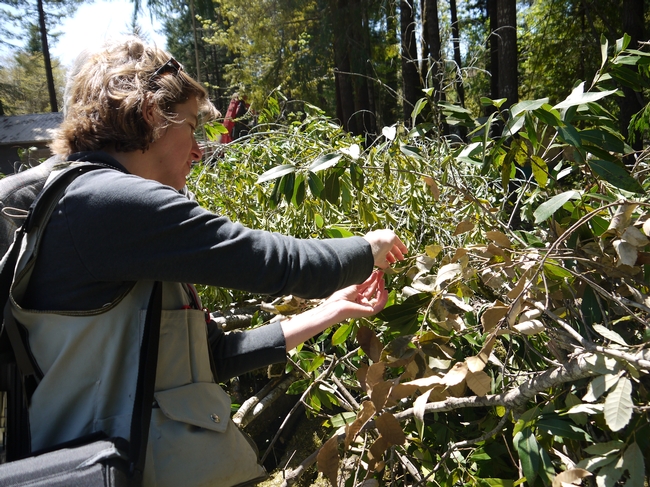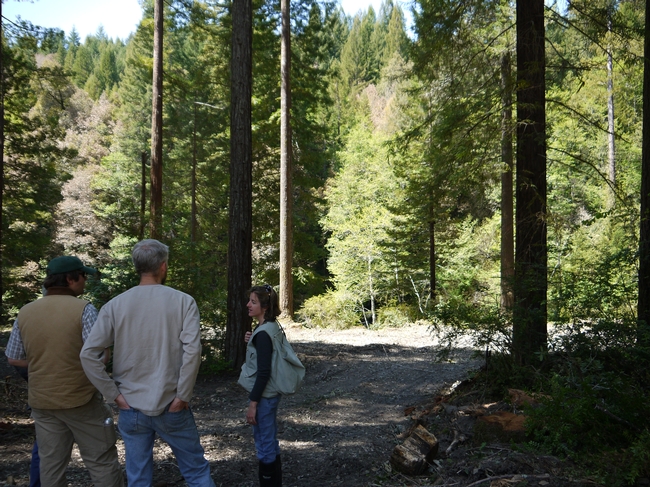University of California Cooperative Extension employees, who coordinate most of the sudden oak death-related research and monitoring in Northern California, got a surprise in the spring of 2010, when samples from a monitoring station near the mouth of Redwood Creek near Orick in Humboldt County tested positive for the pathogen. This meant that trees were infected somewhere in the 200,000-acre watershed – more than 50 miles from the nearest known infestation, and farther north than the pathogen had ever been detected in California.
Federal and state agencies, including the USDA Forest Service, CAL FIRE and the Natural Resources Conservation Service, joined forces with UC Cooperative Extension and quickly mobilized resources to control the pathogen in Redwood Valley and halt its spread to neighboring forests. Local landowners have also played a key role.
Yana Valachovic, UC Cooperative Extension advisor in Humboldt County and forestry expert, explained that she and her agency partners had been preparing for this moment.
“We’ve been closely monitoring the disease for years and anticipating a scenario like Redwood Valley, so we were ready to take action and respond quickly,” Valachovic said.
The UCCE staff leads an extensive sudden oak death monitoring program on the North Coast, and one of their detection strategies involves "leaf-baiting" in streams. Using this technique, they “bait” Phytophthora ramorum, the non-native pathogen that causes sudden oak death, by placing susceptible leaves in strategic locations in North Coast streams. If the leaf baits become infected with SOD, the scientists know that the pathogen is present in the watershed without having to comb the landscape for symptoms.
After they detected the pathogen in Redwood Creek, UCCE acted quickly to pinpoint the source of the waterborne spores, scouring the watershed for the very inconspicuous symptoms of SOD with the help and permission of public and private landowners. By November 2010, the scientists had narrowed the location to Redwood Valley, where they found dead tanoaks and several other infected host plants.
Given its proximity to extensive public, private and tribal lands, the infestation in Redwood Valley was a serious concern. The disease, which was discovered in the Bay Area in the mid-1990s, is found in 14 coastal counties in California, from Monterey to Humboldt, and has infested 10 percent of the at-risk areas in the state. P. ramorum thrives in the coastal climate, and has killed over 5 million tanoaks and true oaks over the past 15 years. It’s still not clear how the pathogen got to Redwood Valley, but it could threaten the dense tanoak forests of the surrounding area, resulting in widespread tree mortality and increased fire hazard.
Much of the on-the-ground effort has been completed by contractors and CAL FIRE handcrews, who have created 100-meter buffers around infected trees by removing California bay laurel (pepperwood) and tanoak, the two hosts that most readily support P. ramorum spore production and spread. Infected plant material has been trucked offsite and donated to the nearby DG Fairhaven Power Company, piled and burned, or lopped and scattered onsite.
Funding from the American Recovery and Reinvestment Act, the USDA Forest Service and NRCS enabled the swift response in Redwood Valley. UCCE used ARRA funds, also known as federal stimulus funds, to hire four people to work on the project, lending stability to the effort.
Landowner support has been critical to the success of the project, according to Valachovic. More than 20 landowners in the valley have allowed monitoring and treatment activities on their properties, recognizing that their cooperation may keep the disease from spreading to other areas.
(NRCS Forester) inspecting a treated area
“We couldn’t just stand back and let the disease roll through the forests that we manage, and the landowners understood that,” said Dan Cohoon, who works for Eureka-based Able Forestry, which manages many of the private forestlands in the watershed.
Brandon LaPorte, manager of Cookson Ranch and one of the key landowner collaborators in Redwood Valley, has supported the project from the beginning. LaPorte explained, “We’ve learned a lot about the disease through this project, and we certainly don’t want it getting worse here on the ranch or spreading beyond the valley.”
The first phase of treatment is currently wrapping up, and UCCE is beginning to monitor project efficacy and watch for spread of the pathogen beyond project boundaries. The Yurok and Hoopa tribes will be paying close attention to this effort, as they are only a ridge away from the infestation.
Ron Reed, a Yurok tribal forester, commented, “Oaks are an important part of our culture and history, and we will do what we can to keep sudden oak death out of our forests.
The Redwood Valley project highlights the value of stream monitoring as a detection tool for SOD, but it also demonstrates the ability of agencies and landowners to collaborate swiftly and effectively to protect the region’s forest resources. Maybe most important – regardless of the future course that sudden oak death takes in the North Coast – is what the project shows about the ability of proactive communities concerned about the health of their landscapes to come together, attract the support of state and national authorities, and work to make things better.
The community collaboration is being honored with the Two Chiefs’ Award. The award, which is given jointly by the NRCS and the Forest Service, highlights projects from across the country each year, recognizing exemplary partners who have worked collaboratively to support conservation and forest stewardship. Valachovic will accept the award on behalf of the federal, state, tribal and private partners involved the project at an event in Davis on Wednesday, May 16.
For more information about sudden oak death disease, visit the California Oak Mortality Task Force website at www.suddenoakdeath.org.
For more ANR news, visit
http://ucanr.edu/news
University of California Division of Agriculture and Natural Resources
Follow ANR on Twitter at twitter.com/ucanr and Facebook at facebook.com/ucanr.